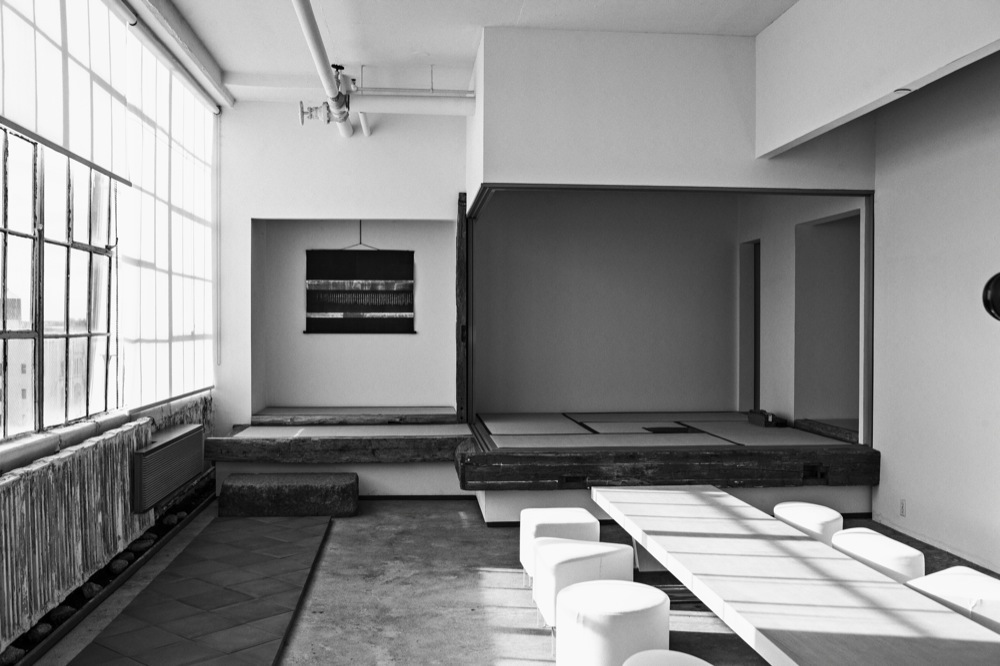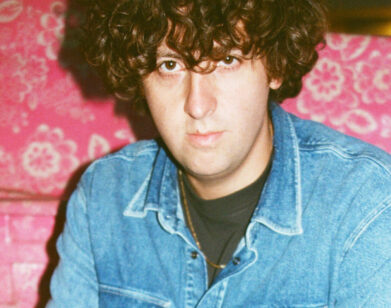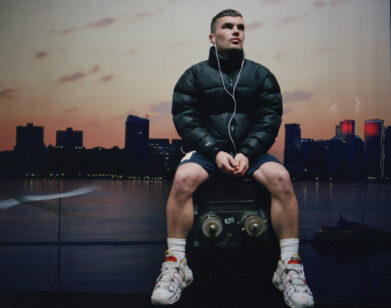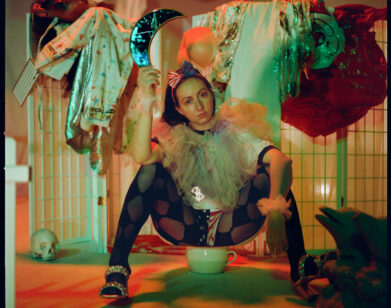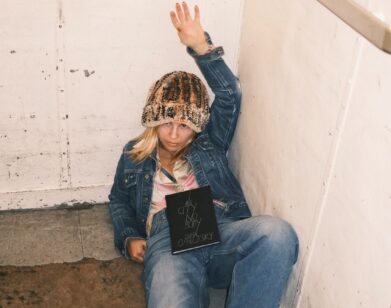Hiroshi Sugimoto’s Future
HIROSHI SUGIMOTO IN NEW YORK, FEBRUARY 2016. PHOTOS: VICTORIA STEVENS.
“The 1,000 Buddha, to me, is almost like a contemporary art piece,” Hiroshi Sugimoto says when we meet him at his Chelsea studio. In 1988, the artist conceived the idea to photograph exactly this scene: 1,000 gilded wooden Buddha sculptures located within SanjÅ«sangen-dÅ (The Hall of 33 Bays), a temple from the 13th century in Kyoto, Japan. Sugimoto struggled to gain permission to photograph inside the temple for seven years, and when finally granted the rights, he had to pay $15,000. “At the very last moment, I was finally permitted. Then they guided me to the financial department temple,” he recalls without a hint of irony. “It’s the commercial aspect of temple sites; it’s nothing to do with my art.”
A selection of the resulting 48 black-and-white photographs were first exhibited at The Metropolitan Museum of Art in 1995, and two years later, when the exhibition traveled to Japan, Sugimoto used the entire series to compose Accelerated Buddha, a five-minute video. Now, at Pace Gallery in New York, Sugimoto presents the video alongside 36 of the images for an exhibition entitled “Sea of Buddha.” Arranged within an oval shape, the photographs reflect one and another from all sides. At first, each image appears identical, instilling a meditative sense of peace, but upon closer inspection, nuances in lighting, composition, and overall tone reveal themselves—shifting the viewing experience to one riddled with anxiety. In the following room, the three-channel video elicits the same change: When the video begins, the 48 Buddha images appear in slow intervals, but as it continues, they appear in rapid succession, creating an effect reminiscent of a stop-motion film being fast-forwarded.
“I keep it updated,” Sugimoto says in regards to changing technology. “This was made in 1997. At that time, the video camera was very low resolution.” The video shown at Pace “is the most recent, highest quality,” he continues. “It’s getting sharper and sharper, so that you can identify each Buddha’s face, even if it’s just for one-hundredth of a second.”
In addition to the Sea of Buddha images and Accelerated Buddha, the exhibition presents five photographs from Sugimoto’s ongoing “Seascapes” series. Considered together, the show explores overarching notions of history, light, and most importantly, time. The day after the opening, we meet the artist, who is now 67 and based between New York and his native Tokyo, to discuss the series as well as death and the demise of civilization.
EMILY MCDERMOTT: This series of photos has never been shown in such a large scale alongside the video. With photographs, it’s up to the viewer how long they stand in front of the work, whereas with the video, the artist dictates the viewing experience. How do you feel about the two being exhibited next to each other?
HIROSHI SUGIMOTO: My concept was, within the five-minute video, for people to see one million Buddhas. So I made a group of the images and it keeps accelerating to reach this one million point. The movie was invented from the still photos. Another side of the concept behind this piece is that most medieval to modern Japanese people, not the contemporary, used to believe and seek religion—same as Christianity. I don’t know how many serious Christians exist here in America, but the Japanese, the younger generation is leaving the Buddhist religion mentality behind. But many people [still] believe that at the time of your death, 1,000 Buddhas show up and welcome you into the paradise state. This is a vision of the point of death; it’s the process of dying. The Buddhist concept is that it takes 48 days to get near this state. So it’s a slow process, moving into, not a permanent death, but the world of the dead.
MCDERMOTT: And it’s a Buddhist belief that living as a human on earth is just one tiny portion of one’s existence.
SUGIMOTO: Yeah, life is one passage and then you keep moving into another state. It’s like you might be reborn, but the process of being born you won’t remember—the same way that the dying process is a slow movement from consciousness to unconsciousness. So this is the five-minute vision of the process of death. It’s the visual presentation of how you will feel death. As an art form, presenting the process of dying is an interesting theme.
MCDERMOTT: You deal a lot with death, time, and our perceptions thereof within all of your work. When this video was shown at the Palais de Toyko [in 2014], it was presented alongside artifacts from your personal collection. How do you think these different contexts impact the perception of the video?
SUGIMOTO: If you go to Kyoto and see the real Sanjūsangen-dŠtemple, you are not able to see the place or the setting. Actually, this is better than [seeing] the real [thing] because my photographs are under the natural light, which only happens for a very short period in the morning in the summertime. Like, 5:30 to 7:30 or 8:00.
MCDERMOTT: The temple is not even open to the public during that time…
SUGIMOTO: No, not even the monks can be there! I was totally alone with my assistant watching this scene. When you go during tourist time, there are so many tourists and florescent light, terrible lighting. SanjÅ«sangen-dÅ faces directly east. The best moment must be seen in the morning, when the sunlight comes up from the East Mountains in Kyoto and hits the screen in the roof. This works as a beautiful filter. Then all of the gold, gilded wooden sculptures shine together, echoing each other. That’s what you see in the video and photographs. It’s better than real.
MCDERMOTT: Do you find yourself drawn to the spirituality or meditative qualities of that moment, opposed to the religious aspects of Buddhism inherently presented?
SUGIMOTO: Well the presentation is, what is the beauty in your mind? The religious feeling comes from the vision sometimes, but this is a visual presentation of the concept of Buddhism. To me, as a visual artist, I don’t want to get into the theory of Buddhism. There are many Buddhism theories and they fight each other, like Christians as well. [I’m concerned with] aesthetics and this idea of how the passage between life and death goes. I can visually present that by borrowing this Buddhist statue.
MCDERMOTT: Have you ever considered yourself religious? I’ve read that you consider yourself spiritual…
SUGIMOTO: Not any particular religion or school of religion, but being an artist, you have to be spiritual, in a way. I don’t love the postmodern statement: “You shouldn’t be spiritual if you are the artist.” [Takashi] Murakami, do you think he is spiritual? He is more like de-spiritualized. [laughs] De-spiritualized might be the most contemporary aspect of the human mind.
MCDERMOTT: So I know the Sea of Buddha series was inspired by Walter De Maria’s The Broken Kilometer, and now, the install for the exhibition is kind of James Turrell-esque. Were you involved with the design of the exhibition?
SUGIMOTO: When I saw this Broken Kilometer, it reminded me of these 1,000 Buddhas. That piece is 1,000 one-meter gold rods, and this is 1,000 pieces of gold gilded wooden sculpture. In terms of design, it’s up to the space’s character. [For the show at Pace] I considered the Musée de l’Orangerie and Monet’s famous painting of water lilies. Waterlilies always come in Buddhist sculpture. The Buddhas all stand on lotus pedestals, because the lotus is grown from the mud. The mud represents the stained world, a dirty world, but growing from the dirt is such a beautiful, pure thing. This is the way the spirit should be.
MCDERMOTT: Have you ever formally studied Buddhism?
SUGIMOTO: Self-taught. I came to California in 1970 and so many people were asking if I was a Buddhist or knew Zen theory, asking if I was enlightened already or not. So I said, “Yes, I am enlightened,” and then I studied quickly to catch up. [laughs]
MCDERMOTT: I also wanted to ask about your personal collection–
SUGIMOTO: I have no policy for my collection. For example, there’s a bunch of meteorite [on the windowsill in my studio]. I touch it and I feel the energy from the universe. I have a 1/1,000th of a fragment of stone-age tools and pottery and debris. I can learn many things from my collection. Actually, the 1,000 Buddha, I wanted to buy it, but it’s a National Treasure, so I couldn’t. If you cannot buy it, just photograph it! And I didn’t have the space to store it, so better just to leave it there…
MCDERMOTT: You had actually offered to give your series to the temple in exchange for them letting you photograph it, right?
SUGIMOTO: Yes, and they said no. They said, “We have the real things. We don’t need a photograph!” But now they realize that my art has gained some high value.
MCDERMOTT: I was going to say, I wonder if they regret that decision now…
SUGIMOTO: Every time I make a show, they ask for [a monetary] “offering.” [laughs] But since it’s from 1,200 years ago, I think the copyright issue should have expired already. Legally, I think I don’t have to. They’re so commercial now.
MCDERMOTT: Religion and state seem entirely intertwined.
SUGIMOTO: They’re tax-free, so, you know, I paid $15,000 without a receipt! Cash only! [both laugh] First I simply asked [permission] through my friend in Kyoto and they said, “No, because you are a commoner.” This is a class society and this is a top-ranking temple in Kyoto; you have to have to have a title or high degree in the court to speak to them. I shouldn’t even speak to them. After seven years, when The Met decided to host my show, [Philippe de Montebello wrote a letter]. The answer was, “American people, they come to see us. We don’t go out to show it.” That’s a beautiful answer, I think. So smug.
MCDERMOTT: I want to expand upon a quote you once said in an interview: “It was only in the 19th century that art finally started to depict its own character. It was finally freed from religion.” With this series, though, you’re turning your art to look at religion.
SUGIMOTO: Art and religion have the same origin. Art first, or religion first? Maybe consciousness first! Consciousness always comes with religious feeling and artistic identification. It’s the same origin. Art always helps religion; it became an inseparable phenomenon when human beings gained consciousness. Later, it separated to religion and art. I want to put it back together now, this artistic expression that contains religious feeling. I want to investigate: What was the origin? What’s happened in the human mind? Can we trace back the moment of the creation of human consciousness? And why did only humans gain consciousness, not other animals? So, evolution? I don’t know whether or not I can believe evolution. Maybe we wait for another 100,000 years and then apes get consciousness.
MCDERMOTT: Even the statement on your website about this series questioned whether or not conceptual art will last another 800 years…
SUGIMOTO: I’m thinking about the end of civilization. We may not keep growing like we are now. There must be an end of civilization. That’s what I did as a show at the Palais de Tokyo, the 33 scenarios of how this civilization ends. Again, this is 33, reflecting the 33 Bays. I don’t know what the concept is behind [the number 33]. Forty-eight is the number of stages of death. Thirty-three is a key number in between at some point.
MCDERMOTT: And then you are exhibiting 36 images from the 48 total…
SUGIMOTO: Because of the size of the space. I wanted to show all 48 of them, but I couldn’t. Sometime, if I’m able to use a bigger space, like a museum, that can be ideal.
MCDERMOTT: What about the sounds in the video, where do they come from?
SUGIMOTO: The sound I commission from a contemporary composer, Ken Ikeda. He’s the husband of Mariko Mori. I’ve known him for a long time. It’s just a simple noise, including notes higher and lower than you can hear. It’s a very hypnotizing effect, kind of irritating. It has been recomposed for this iteration. It was very similar [before], but with more banging sounds. It’s a choice to have sound, but it’s effective. Getting into the video presentation, I feel like I’m laying down in a coffin and people think I’m dead but my consciousness is still there. I cannot move, but I have a vision of the 1,000 Buddhas guiding me to the afterlife. It’s an imaginative vision of moving to the afterlife state.
MCDERMOTT: How do you feel like the two series, “Seascapes” and “Sea of Buddha,” speak to each other being within the same space?
SUGIMOTO: It’s representing the time passages between life and death. The Seascapes are before human beings and after human beings. The Seascapes were there before our presence, and when our civilization is over, seascapes will still exist. Our presence is temporary. Civilization is only 5,000 to 6,000 years. The history of ours, the material history of consciousness, is rather short. Where do you draw the line as a human being? Written record is only, what, a couple thousand years? And this scientific revolution is less than a hundred years. And computers only a few decades! We’ve changed so much. It’s amazing, the speed of changes.
MCDERMOTT: Is this speed what you see causing civilization’s demise?
SUGIMOTO: I have a strong feeling about this quick movement and changing of society and populations growing—something scary. Can we just keep building like this? Manhattan is amazing. In 100 years, we’ve built this much.
MCDERMOTT: When you’re thinking about the end and the beginning so much, and these transient states of being, do you ever find it difficult to truly be present in the moment?
SUGIMOTO: I feel that I’m in a very interesting position, where I’m standing back to look at this change, at this moment in history of human beings. If the end of the civilization comes before the end of my life, that’s lucky! I want to witness how this big story of humans ends. It may keep running, or there might be a turning point to going backward. I don’t know whether the future or 2018 exists or not, but if it exists, I’m offering a show to a museum in Australia titled “Time Reversed.” Time is going backwards.
MCDERMOTT: I feel like we need to slow down in order to understand what’s happening.
SUGIMOTO: Yeah, population diminishing, even in Japan and Italy, the population is diminishing. When society can reach a sustainable place or gain comfortable income, then people tend to have fewer children. Poverty makes a chain reaction of having many children. So when society reaches some kind of level, then it will turn toward getting a smaller population, I hope. Otherwise it won’t be sustainable. Then we need to have nature back in our atmosphere. There might be a turning point of going backward—within a few thousand years we are going back to the Stone Age! There are many scenarios [with] the robot technologies: Humans no longer need to walk; machines can produce products and food and everything. You might not be able to recognize what’s false and what is real.
“SEA OF BUDDHA” WILL BE ON VIEW AT PACE GALLERY IN NEW YORK THROUGH MARCH 5, 2016.

